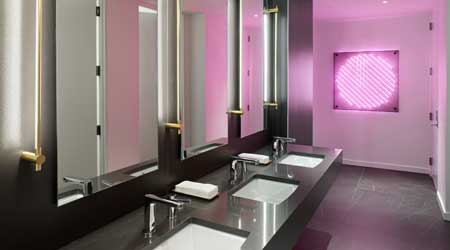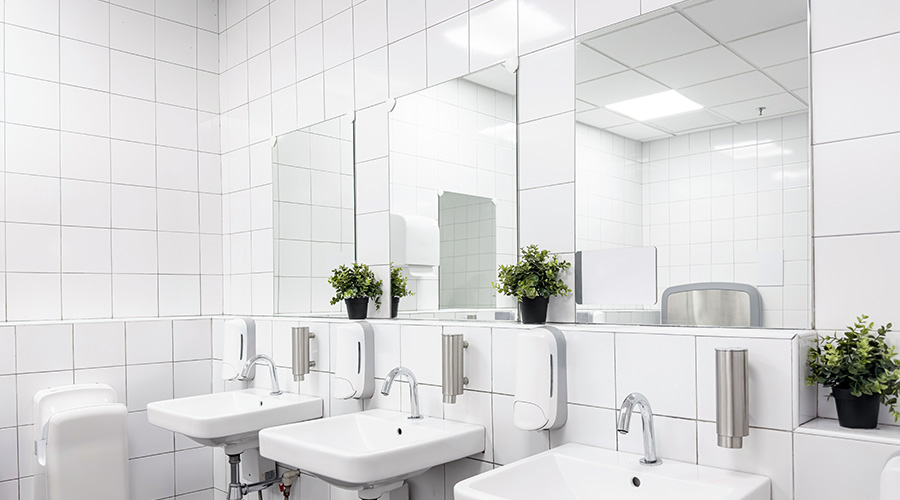Restroom Design in the Time of COVID-19
The pandemic will dramatically alter how restrooms function, and therefore, how restrooms should be designed. Here's what you need to know.
Public restrooms are often the most visited spaces in a commercial facility. Why then is the design approach to these areas often so uninspired? While this disconnect is an opportunity for developers and property owners to take a new look at the restrooms in their projects, outside factors, such as the current COVID-19 pandemic and increased social and environmental awareness, make it a necessity. The time is ripe to drive new thinking in public restroom design — to create a cleaner, safer and simply better experience. But before taking a closer look at these topics, it is important to understand the way the past has shaped the evolution of restroom design today.
In the latter half of the 1800s, there was both limited access to widespread public utilities and a limited understanding of the health benefits of public sewage systems. A large part of the population was still using outhouses. Views started to change at the beginning of the 20th Century, and restroom functions began to move inside. To help create widespread acceptance, these spaces were designed to take on the ornate characteristics of existing rooms in homes and public spaces of that time. Fixtures were typically housed in decorative carved wood surrounds to appear like furniture. Windows and floors were covered in drapery and throw rugs while walls were covered in wallpaper — all things that would make a modern virologist run screaming.
This changed quickly, however, with the onset first of the rise of tuberculosis, followed soon after by the influenza pandemic, to which parallels have been drawn to the current COVID-19 pandemic. With these diseases came a much better understanding of the way viruses spread and of the important role materials and surfaces played in stopping these viruses. Gone were porous woods, fabrics and wallcoverings, replaced by enamel, stainless steel and ceramic tile that echoed the sterile and clinical feel of the many sanatoriums created during that era to treat the patients of those pandemics. This model continued largely unchanged throughout the 20th Century and only recently has begun to evolve beyond the singular focus of hygiene to include a more holistic approach. This new approach offers a space that is sanitary and thoughtfully designed to create a higher level of convenience, as well as a unique user experience. The question now is, given our current COVID pandemic, do the restrooms of today need to shift back to the purely sterile and utilitarian model borne out of the last great pandemic, or can they reflect some of the warmth and hospitality of their Victorian-era cousins?
While addressing COVID-19 will rightfully continue to be a primary focus, contemporary public restroom design should consider a large number of factors that will improve the customer experience. As businesses reopen, health and safety of course will need to be addressed to relieve any uncertainty that customers might have about returning to public spaces. But accessibility, sustainability and convenience, coupled with a unique and memorable design, should also be reviewed.
Sanitation has long been a driving focus of modern, public restrooms. And if modern restrooms include touchless applications, they are ahead of the curve. Moving forward, the standard baseline should be touchless sensors for all restroom fixtures. These technologies will continue to improve as evidenced by the recent introduction of combination faucets with high-speed air dryers that are more efficient than their wall-based, heat-generating counterparts. These new technologies are convenient and eliminate trails of water on counters and floors that germs thrive on. Current studies, however, indicate that the tried and true paper towel might be better than dryers, which can spread aerosolized particles and increase the risk of infection. With that in mind, design thinking also should strive to integrate multiple trash receptacles within counters and place paper towels under mirrors to further eliminate trails of water and potential trash on the floor. In addition to more visible elements of sanitation, the perception of social distancing and privacy will be a growing issue that will need to be considered. Urinals with full-height partitions and toilet stalls with full-height doors and partitions along with dedicated individual ventilation would go a long way in addressing these concerns. A rethinking of the overall restroom layout to place individual sinks in each toilet stall and eliminate the common sink area, might not be far behind.
Related Topics:













